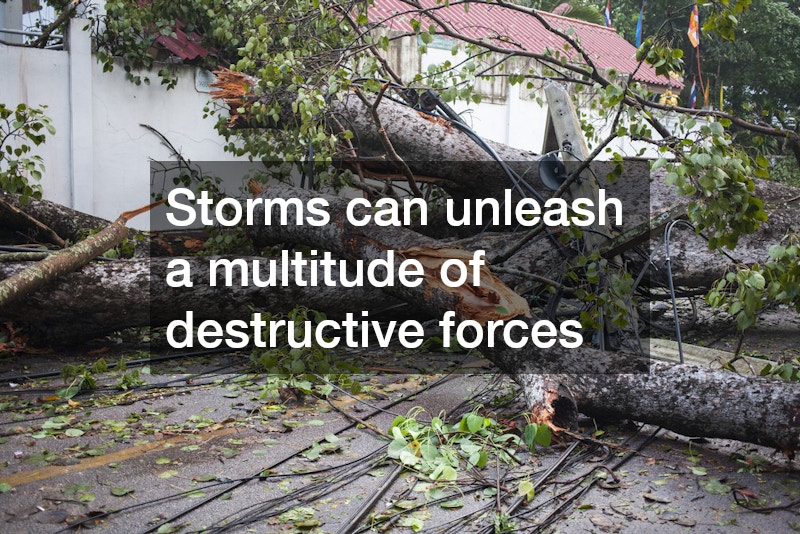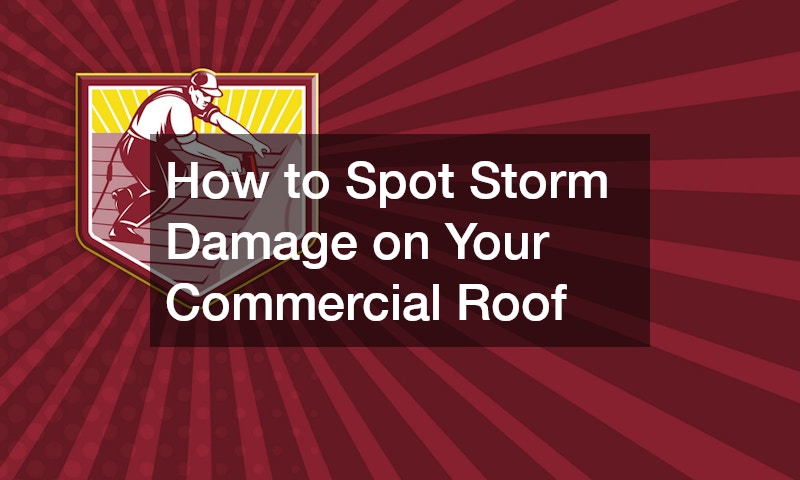Storms can cause significant damage to commercial properties, especially the roofing systems that protect them. Identifying such damage early can save businesses from extensive repairs and financial loss. In this article, we’ll provide a detailed guide on how to spot storm damage on your commercial roof with insights from a reliable commercial roofing company.
Understanding the Impact of Storm Damage
Storms can unleash a multitude of destructive forces, including high winds, hail, and heavy rain, each capable of inflicting different types of damage on a commercial roof. High winds can lift and even remove roofing materials, leaving the underlying structure vulnerable to further damage.
Hail, on the other hand, can cause punctures and dents, which may not be immediately visible but can lead to leaks over time. Heavy rain, when combined with already compromised roofing materials, can infiltrate the roof and cause internal water damage. It’s essential to comprehend the nature of these damages to identify them effectively after a storm.
Onsite inspections conducted by experienced professionals are crucial because some damages are not visible to the untrained eye. A commercial roofing company can provide in-depth assessments using specialized tools and techniques. These inspections often include checking for loosened or missing shingles, compromised flashing, and examining areas most vulnerable to water pooling. By understanding these impacts, business owners can prioritize maintenance and preventative strategies for storm preparedness. Without this understanding, even a small oversight can lead to costly repairs and operational disruptions.
Moreover, understanding storm impacts aids in the development of a response plan, ensuring timely repairs and minimizing business interruptions. By knowing what to expect, facility managers can promptly initiate insurance claims with accurate documentation provided by a commercial roofing company. Employing this proactive approach not only extends the lifespan of the roof but also enhances the overall safety and operational efficiency of the business. Ignorance here can be detrimental, leading to cascading consequences and operational vulnerabilities post-storm. Awareness and preparation form the first line of defense against storm-induced damages.
Common Signs of Roof Damage After a Storm
After a storm, visible signs of roof damage can manifest in several forms, serving as immediate red flags for property owners. One primary sign is the presence of shattered or displaced roofing materials such as shingles or tiles. These materials, designed to shield the internal layers of the roof, when compromised, expose the structure to potential water infiltration. Additionally, visible leaks inside the building or water stains on the ceiling and walls can be direct indications of roof damage. Such visible signs necessitate immediate attention to prevent escalation into more severe issues.
Other notable indicators include the discovery of granules in gutters or along the building’s perimeter post-storm. Granules, often found on shingles, provide UV protection and add a layer of fire resistance; their absence signifies wear and exposure to harsh elements. Professionals from a commercial roofing company can assess gutter contents to estimate the extent of roofing damage incurred during a storm. Furthermore, interior manifestations like musty odors or sudden increases in indoor humidity levels may indicate roof failure. These signals often accompany compromised insulation due to water intrusion, requiring prompt investigative actions.
It’s also essential to pay attention to structural changes, such as sagging rooflines or bulging walls, which can indicate severe underlying issues. Such structural irregularities often arise post-storms due to prolonged water exposure or weight-induced stress. Professional inspections can help differentiate between cosmetic and structural damages, guiding necessary repair or replacement actions. Ignoring these signs not only exacerbates potential damages but also elevates repair costs and risks of operational downtimes. Timely detection and intervention are vital in maintaining the integrity and longevity of a commercial roofing system.
Enlisting Professional Help for Roof Inspections
When storm damage is suspected, enlisting the expertise of a commercial roofing company is a crucial step in ensuring comprehensive assessments and repairs. Professional roof inspections offer a meticulous evaluation of damage invisible to the untrained eye, guaranteeing that no underlying issues are overlooked. Experienced roofers use advanced equipment, such as infrared cameras and drones, to identify moisture accumulation and compromised insulation effectively. Such inspections are fundamental in avoiding superficial repairs that address only visible damages, leaving latent issues unaddressed. The insights garnered through professional evaluations form the foundation for reliable and long-lasting repair solutions.
Furthermore, commercial roofing companies provide valuable documentation needed for insurance claims, expediting the process and enhancing claim success rates. Detailed reports and photographic evidence compiled by professionals substantiate claims and ensure that property owners receive fair compensation for repair costs. This partnership with roofing experts enables business owners to focus on core business operations while professionals manage the restoration process. In the unfortunate event of storm damage, timely interventions guided by experts minimize operational interruptions and safeguard the building’s structural integrity. The peace of mind offered by knowing your property is in expert hands is invaluable.
Regular inspections and maintenance, even outside of storm events, play a pivotal role in sustaining the health of a commercial roof. Proactive roof management strategies implemented by a commercial roofing company can prevent minor issues from escalating into significant, costly problems. Scheduled inspections throughout the year ensure that the roof is resilient against varying weather conditions, reducing vulnerability during storm seasons. By investing in routine checks and timely repairs, businesses can extend the lifespan of their roofing systems and strengthen their defenses against storm-induced damage. This strategic approach prioritizes not only the roof’s health but also the business’s financial stability and operational efficiency.
Developing a Storm Preparedness Plan
Comprehensive storm preparedness plans are indispensable for businesses located in storm-prone areas, focusing on prevention, protection, and recovery strategies. An effective plan begins with detailed assessments of potential risks, aided by professionals from a commercial roofing company to identify roof specific vulnerabilities. This proactive measure is critical in customizing protection strategies that aim to minimize impact and facilitate recovery in the aftermath of a storm. Such plans often include guidelines on pre-storm inspections, necessary reinforcements, and training staff on emergency protocols. By encompassing these components, businesses can mitigate potential damages, enhancing resilience against future storms.
Communication forms a cornerstone of any preparedness plan, involving explicit instructions for staff on roles, responsibilities, and safety measures before, during, and after a storm. Regular drills and updates ensure that everyone is informed and ready to act when necessary, minimizing confusion and optimizing response times. Additionally, establishing contacts with a reliable commercial roofing company and other essential service providers is crucial for expedited services post-storm. These preparations reduce stress and uncertainty, offering a structured approach to managing potentially chaotic scenarios and streamlining recovery efforts. Effective communication is vital in safeguarding both human and material assets throughout the storm cycle.
Reviewing and updating storm preparedness plans annually or after significant weather events ensures their relevance and efficacy in addressing evolving risks. Optimum preparedness considers advancements in technology and emerging construction materials that fortify commercial roofing systems against storm impacts. Collaborations with roofing professionals to examine plans and roof conditions can highlight areas needing improvement or reinforcement. This ongoing evaluation process, supported by expert guidance, aligns business goals with robust safety protocols, contributing to overall resilience and risk reduction. Addressing identified gaps before storms strike can yield substantial returns in continuity and operational stability.
In conclusion, understanding and addressing storm damage to commercial roofs requires a proactive approach supported by professional expertise. By recognizing signs of damage, enlisting the aid of a commercial roofing company, and implementing a storm preparedness plan, businesses can safeguard their operations against potential threats. Investing in these measures not only protects physical assets but also contributes to long-term financial stability and growth. Adequate preparation and expert guidance ensure that commercial roofs, and the businesses beneath them, withstand and recover from the inevitable forces of nature.

